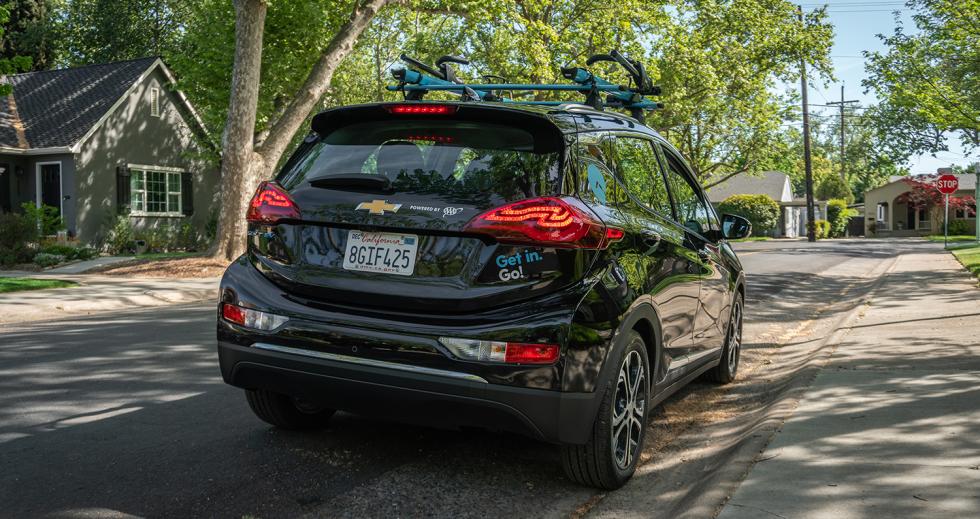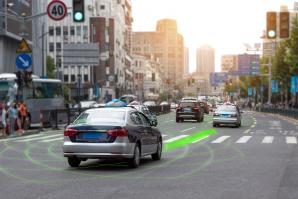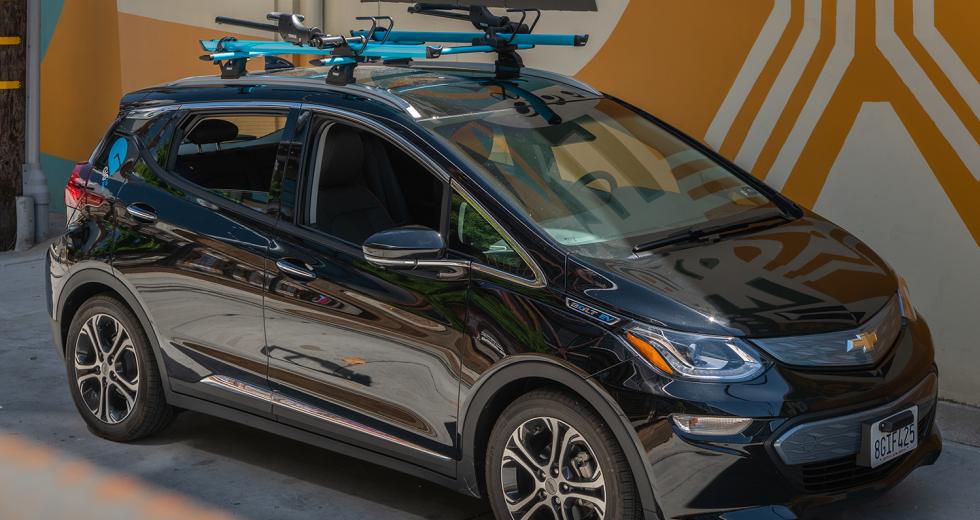In April, one year after a flock of red Uber-owned Jump bikes showed up around downtown Sacramento and two months after a swarm of red Jump scooters appeared, 260 black Chevy Bolts sporting bright blue GIG (Get In and Go) decals and bright blue bike racks arrived at curbs in neighborhoods throughout the city.
Seemingly overnight, instant car rentals have become a local thing: Download the GIG Car Share app. Punch in your credit card digits and a photo of your driver’s license. Click the green drop-pin. Walk to the car and unlock it with your smartphone. At the end of a trip, you get out and walk away. As of early July, more than 2,500 people had downloaded the app, accounting for more than 80,000 trips, according to Jennifer Venema, sustainability officer with the City of Sacramento.
The nation’s only fleet of “floating” electric car-share vehicles is the newest evidence of a transportation revolution taking off in Sacramento. GIG is one piece of a combined effort by the city, SMUD, local colleges and universities and many other players to make the Sacramento region the leader of the new-mobility revolution.
But this fleet of electric vehicles also represents a major initiative by AAA, formerly the American Automobile Association, one of the oldest brands in the automotive industry. Michael Blasky, media relations specialist for GIG Car Share, says this is the first new product the 117-year-old company has launched in two decades.
“We realized that the business of transportation was changing,” Blasky says, “and saw what we believe to be a pretty obvious shift towards transportation as a service option, especially among younger motorists. We were looking for ways to innovate and come up with new products that would serve our members for the next 100 years.” (While the service does not require AAA membership, members get a 10 percent discount.)
AAA’s primary business model is roadside assistance, and it is a big player in auto insurance, both of which target members’ privately owned vehicles. Blasky points out that many studies predict the demand for vehicle ownership declining rapidly. “When we think about the future, there’s a lot of reasons to innovate,” Blasky says. “The old model is definitely changing.”
The First ‘Green City’
The new model is similar to the service Zipcar rolled out in 2000. Zipcar, which has a fleet of 10,000 vehicles worldwide and says to have more than 1 million members, was acquired by Avis Budget Group in 2013. While Zipcar requires a customer to pick up and drop off at specific locations, GIG cars are “dock-less” because they can be picked up and dropped off just about anywhere within a “home zone.” GIG also has no sign-up or monthly fees, while Zipcar does.
While Zipcar’s pricing varies from city to city — its advertised Sacramento rate is $9.50 per hour, or $79 per day, on top of a $7 per month membership fee, GIG charges drivers on a sliding scale: $0.40 per minute, $15 per hour, or $85 per day, whichever its algorithm determines to be cheapest.
GIG’s expenses include a team of “Fleet Magicians” to maintain and re-charge the vehicles, and the electric bill. But the company did not have to pay for $7 million worth of cars, nor did it have to build out the infrastructure to charge them — costs that might have been show-stoppers — thanks to Sacramento’s designation as Electrify America’s first “Green City.”
Electrify America is a subsidiary of Volkswagen, created following the 2015 “Dieselgate” scandal, which revealed that the automaker had tricked regulators regarding its smart-diesel engine’s emissions. The technological subterfuge had masked the fact that the vehicles emitted dangerous amounts of nitrogen oxide, a carcinogen.
As part of VW’s $25 billion global settlement, Electrify America, through its Green Cities program, is spending $44 million in Sacramento, with more than $15 million subsidizing GIG. As its name suggests, Electrify America’s primary mission is to build the infrastructure that allows drivers to switch from petroleum to electrons, an effort designed to decrease emissions and improve air quality. That means spending $2 billion over 10 years building charging stations, $800 million in California.
Richard Steinberg, Electrify America’s director of marketing and communications, says he believes this infrastructure will both enable and benefit from the increased use of EVs. “We aim to help encourage the adoption of electric vehicles by overcoming one of the primary objections that people have to buying one, which is ‘Where am I going to charge it?’” he says. “That’s our primary mission — install fast DC chargers.”
The Green Cities investment in GIG might turn out to have a nice piece of business symmetry: While fulfilling its court-ordered mandate to help clean the air, Electrify America is also creating demand for its own product.
“Our goal is to be in the charging business,” Steinberg says. “What we’re doing here is sort of jumpstarting that by giving, in the case of GIG, 260 cars the opportunity to utilize our chargers. That’s where our revenue stream will come from. And as we reach the end of our 10-year commitment, we’ll have all these assets in the ground generating revenue.”
Most of the charging for EVs today takes place at home. But as more and more people decide they can rely on them as a primary vehicle, that likely will change. Electrify America installing close to 500 charging stations along popular routes in California, including one string of stations connecting Sacramento to the Bay Area and Lake Tahoe.
“You can start to see the chicken-or-egg thing beginning to resolve itself,” Steinberg says.
Steinberg came to Electrify America from BMW, where he was on the team developing its futuristic i8 and utilitarian i3, and previously worked with Nissan, whose Leaf was the best-selling electric vehicle until last year, when the Tesla Model 3 blew it away (138,000 Model 3s vs. 85,000 Leafs). He pays close attention to the electric-vehicle market and points out that we are about to see a wave of innovation from carmakers here and abroad. “That bodes well for the charging business,” he says.
GIG Car Share launched its fleet of all-electric vehicles in
Sacramento in April. (Photo by Dekiary Carter/courtesy of GIG Car
Share)

Back to the Future
Many of the chargers Electrify America is installing in the region are capable of putting out a lot more power than today’s batteries can hold. Stenberg calls this “future-proofing” — better batteries are surely on the way.
GIG’s Blasky says his division and AAA are similarly future-focused and gearing up for what they see as an automotive inevitability: the decline of the single-owner, petroleum-fueled automobile and the widespread adoption of autonomous vehicles. In November 2018, AAA purchased GoMentum Station at the former Concord Naval Weapons Station. It is now one of the largest self-driving car testing facilities in the world.
“Our focus on self-driving cars is about making sure that this technology is rolled out safely,” Blasky says. “Our viewpoint is that this is an incredible technology that has the utmost potential to save countless lives — around the world, you’re talking about a million deaths a year, almost 90 percent of those caused by human drivers’ error.”
Driver safety is one of the cornerstones of Sacramento Mayor Darrell Steinberg’s stated goal of making Sacramento the capital of the transportation revolution, according to Venema.
“It’s not just technology for a shiny technologies’ sake,” she says. “It’s really about: How do we achieve our climate and environmental goals, make air more breathable, and safely get people that more affordable, reliable way to get around?”
Electrify America’s Steinberg (no relation to the mayor) credits local officials with making it easy to do business here, and believes the burgeoning new-mobility industry will have an impact on the region’s economy. “It looks good for Sacramento to be a leader in the space,” he says. “There’s a lot of people engaged in this particular initiative, and we’re all talking to each other. So long term, this is sort of ground zero.”
Recommended For You

Marketing for Mobility
SMUD CEO Arlen Orchard envisions new center making the region a major player in the transportation revolution
A group of public and private sector leaders in Sacramento are working to craft a protocol for self-driving vehicles that could be replicated in other municipalities across the country.

Electric Avenue
How will Sacramento’s designation as a ‘Green City’ shift the transportation landscape?
Last summer, Sacramento learned it would become Volkswagen’s first “Green City,” earning millions in investment from the tarnished brand’s subsidiary, Electrify America. Where will this money go, and what does it mean for the local auto technology industry?



